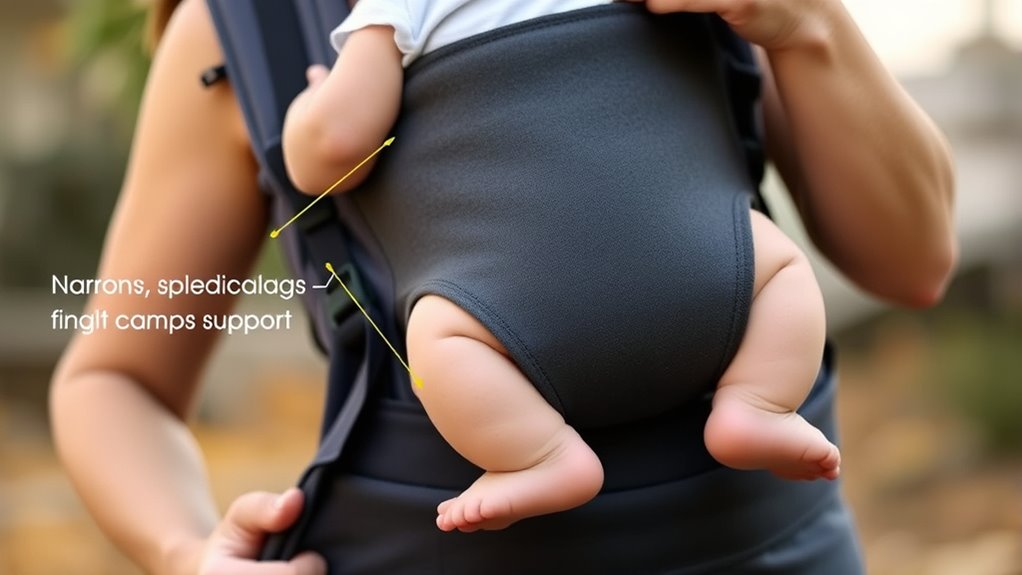To determine if your baby carrier is truly ergonomic, look for breathable, chemical-free fabrics that feel comfortable and safe for your child’s skin. Check if it offers proper support with features like wide leg openings and adjustable straps to guarantee correct positioning. Be wary of carriers from brands with poor safety records or vague instructions, as these raise red flags. Keep an eye out for signs of genuine ergonomic design—if you notice these details, you’re on the right track. You’ll discover more helpful tips to keep your little one safe and comfortable.
Key Takeaways
- Check if the carrier supports proper ergonomic positioning for both baby and parent, avoiding slouching or strained postures.
- Look for high-quality, chemical-free materials that are breathable, hypoallergenic, and free from harmful dyes or odors.
- Ensure the carrier distributes weight evenly to prevent shoulder, neck, or back discomfort.
- Verify that the brand adheres to current safety standards and has a transparent reputation for quality and safety.
- Be cautious of carriers with stiff fabrics, poor stitching, or vague safety instructions, which may indicate low ergonomic support.

Ergonomic baby carriers are designed to support both your child’s comfort and your own, making everyday routines easier and more enjoyable. But how do you know if the carrier you’re using truly offers ergonomic benefits? One of the first red flags to watch out for is questionable material safety. When examining a carrier, always check what it’s made from. High-quality carriers use fabrics that are breathable, hypoallergenic, and free from harmful chemicals like phthalates or dyes that could irritate your baby’s sensitive skin. If the material feels stiff, cheap, or has a strong chemical smell, it’s a sign you should reconsider. Remember, the safety of the materials directly impacts your child’s health, so never compromise on this aspect. Additionally, understanding types of baby carriers can help you identify which designs are more likely to be ergonomic and supportive for both parent and child. It’s also helpful to look into ergonomic design principles to better evaluate how well a carrier supports healthy development and comfort. Recognizing supportive features in a carrier can make a significant difference in ensuring proper weight distribution and reducing strain on your body. Observing whether a carrier incorporates proper weight distribution can further ensure ergonomic support. Being aware of the latest trends in safety standards can help you choose a carrier that meets current safety benchmarks. Brand reputation also plays a critical role in determining whether a carrier is truly ergonomic. Trustworthy brands invest in rigorous testing and adhere to strict safety standards, which often translates into better design and higher-quality materials. If a brand has a history of recalls, poor customer reviews, or vague safety information, it’s a warning sign. Reputable companies are transparent about their manufacturing processes and provide detailed instructions on proper use, ensuring you can carry your baby comfortably and safely. It’s always wise to research customer feedback and expert reviews before making a purchase. A well-regarded brand frequently updates its designs based on ergonomic research and user feedback, which helps prevent common issues like poor weight distribution or uncomfortable straps.
Frequently Asked Questions
How Do I Adjust a Carrier for Different Baby Sizes?
When adjusting a carrier for different baby sizes, you need to focus on adjusting the fit to guarantee comfort and support. Varying sizes require you to tighten or loosen straps, reposition the seat, and ensure the baby’s hips are in an ergonomic M-position. Check the manufacturer’s guidelines for adjusting the carrier properly. Always make sure the carrier offers snug support for your baby’s changing size, promoting healthy hip development and comfort.
Are All Ergonomic Carriers Suitable for Newborns?
Not all ergonomic carriers suit newborns. You need one with a soft, supportive fabric that’s gentle on delicate skin and maintains its durability with frequent use. Look for an ergonomic design that offers proper head and neck support, ensuring safety and comfort. If a carrier lacks adjustable features or doesn’t distribute weight evenly, it might not be ideal for newborns, so choose wisely to keep your little one safe and comfy.
Can a Carrier Cause Long-Term Back Problems?
Think of your back as a fragile garden that needs careful tending. If you neglect proper posture correction, a poorly designed carrier can become weeds that cause long-term back problems. Look for carriers made of durable materials that offer proper support. Poorly constructed carriers may seem comfortable initially but can strain your back over time. Choose wisely to safeguard your posture and ensure lasting comfort for both you and your baby.
How Often Should I Replace My Baby Carrier?
You should replace your baby carrier when it reaches its carrier lifespan or shows clear replacement indicators. Generally, inspect for frayed straps, weakened buckles, or fabric tears—these signs mean it’s time for a new one. Regular use and washing can wear down materials faster, so stay attentive. Replacing your carrier ensures safety and comfort for both you and your baby, preventing potential risks from compromised support or structural integrity.
Are There Safety Certifications to Look For?
You’d be stunned how many baby carriers skip safety certifications, risking your little one’s well-being! Always look for safety standards and certification marks on the label—these are your superheroes against potential hazards. If a carrier lacks recognized certifications, it’s like playing a game without rules. Trust brands that meet safety standards, ensuring your baby stays snug and secure. Don’t settle for less—your baby’s safety deserves certification marks you can count on.
Conclusion
Now that you know what to look for, you can confidently choose a carrier that truly supports your baby and your comfort. Spot the red flags, ask the right questions, and prioritize safety and ergonomics. Don’t settle for less—trust your instincts, evaluate each feature, and remember that a good carrier is about more than just looks. Because when you pick the right one, you protect your baby, support your back, and enjoy every moment together.









